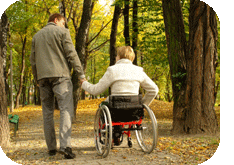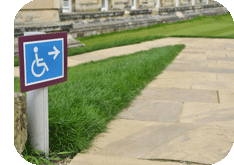ADA Regulation Changes in 2012: A quick overview of significant changes
"Beyond disability, there are abilities; beyond accessibility there is inclusion", Keith Christensen
 Since 1990, when the Americans with Disabilities Act was signed into law, designers and developers have been battling with the complexities of the regulations. Questions and confusion arose regarding flaws in the standards leading to subsequent amendments and guidelines which were reviewed, prepared and adopted. Many of these guidelines (including the 2010 ADA Standards for Accessible Design for Recreational Facilities) have been integrated into the Federal Standards which were adopted in September 2010. Though officially adopted, these standards will not become mandatory until March 15th of 2012, so, if you haven't done so already, now is the time to familiarize yourself with them! One of the most visible changes to the regulations is the addition of standards for recreational facilities. This issue of LAND Connections will focus on a few of the many changes to the Federal standards as they relate to the outdoor environment.
Since 1990, when the Americans with Disabilities Act was signed into law, designers and developers have been battling with the complexities of the regulations. Questions and confusion arose regarding flaws in the standards leading to subsequent amendments and guidelines which were reviewed, prepared and adopted. Many of these guidelines (including the 2010 ADA Standards for Accessible Design for Recreational Facilities) have been integrated into the Federal Standards which were adopted in September 2010. Though officially adopted, these standards will not become mandatory until March 15th of 2012, so, if you haven't done so already, now is the time to familiarize yourself with them! One of the most visible changes to the regulations is the addition of standards for recreational facilities. This issue of LAND Connections will focus on a few of the many changes to the Federal standards as they relate to the outdoor environment.
General Exemptions: The following exceptions have been added to the standards (with limitations): Raised areas for life and fire safety, single occupant structures, employee work areas and raised refereeing judging and scoring areas (max 500 s.f.).
Recreational Facilities: Since 2002, unenforceable guidelines for accessibility in recreational facilities have been available; however, the 2010 ADA Standards for Accessible Design now include specific criteria related to recreational facilities including: amusement rides, recreational boating facilities, exercise machines and equipment, fishing piers and platforms, golf facilities, miniature golf facilities, play areas, pools and spas and shooting facilities. This also includes spectator seating areas, team and player seating, fields and court sports, dressing and locker rooms, saunas and steam rooms, petting zoos and bowling lanes. It is important to note that each of these facilities are now regulated by ADA standards and many people will not be familiar with them yet. Closely related to these facilities are new regulations stating that outdoor lawn and overflow seating must be connected to an accessible route and that wheel chair spaces in assembly areas must be provided at a ratio of 4 per 150 seats and have companion seats and designated aisle seats.
 Accessible Sites, Routes & Parking: A variety of changes have been made to the regulations related to accessible routes and parking. Some of them include:
Accessible Sites, Routes & Parking: A variety of changes have been made to the regulations related to accessible routes and parking. Some of them include:
- An accessible route is no longer required if the only access to the site is vehicular with no pedestrian access.
- An accessible route between building and facilities within a site is no longer required if the only access to the site is vehicular with no pedestrian access.
- A minimum of 60% (was previously 50%) of public entrances must now be accessible.
- Cross slopes not to exceed a 1:48 maximum (was previously 2%)
- Handrails may now protrude into a path of travel at a maximum of 4.5"
- Van parking is required at a rate of 1/6 (was previously 1/8) of accessible spaces.
Ramps & Stairs: A variety of changes have been made to the regulations related to accessible routes and parking. Some of them include:
- Detectable warnings are no longer required at curb ramps, reflecting pools or hazardous vehicular areas unless the project is a Department of Transportation project.
- A 36" min. landing at the top of a curb ramp is now required.
- Curb ramps may not project into parking spaces or access aisles.
- Cross slopes on ramps and landings are not to exceed a maximum slope of 1:48 (was previously 2%)
- Edge protection is now required on both ramps and landings.
- Stair risers are now to be between 4"-7" with a min. 11" tread.
- Round hand rails are now to be 2" in diameter and non-circular rails are to have a perimeter dimension of 4"-6.25".
- Bottom hand rail extensions are to be 1 tread depth beyond last riser nosing. (was previously 12" plus tread depth)
Drinking fountains: Where a drinking fountain is provided there must now be two drinking fountains unless one model can be shown to meet all requirements.
These are just a few of the many changes that will become active as of March 15, 2012. Visit our resource center for links to online Federal ADA documents and additional information.
 Since 1990, when the Americans with Disabilities Act was signed into law, designers and developers have been battling with the complexities of the regulations. Questions and confusion arose regarding flaws in the standards leading to subsequent amendments and guidelines which were reviewed, prepared and adopted. Many of these guidelines (including the 2010 ADA Standards for Accessible Design for Recreational Facilities) have been integrated into the Federal Standards which were adopted in September 2010. Though officially adopted, these standards will not become mandatory until March 15th of 2012, so, if you haven't done so already, now is the time to familiarize yourself with them! One of the most visible changes to the regulations is the addition of standards for recreational facilities. This issue of LAND Connections will focus on a few of the many changes to the Federal standards as they relate to the outdoor environment.
Since 1990, when the Americans with Disabilities Act was signed into law, designers and developers have been battling with the complexities of the regulations. Questions and confusion arose regarding flaws in the standards leading to subsequent amendments and guidelines which were reviewed, prepared and adopted. Many of these guidelines (including the 2010 ADA Standards for Accessible Design for Recreational Facilities) have been integrated into the Federal Standards which were adopted in September 2010. Though officially adopted, these standards will not become mandatory until March 15th of 2012, so, if you haven't done so already, now is the time to familiarize yourself with them! One of the most visible changes to the regulations is the addition of standards for recreational facilities. This issue of LAND Connections will focus on a few of the many changes to the Federal standards as they relate to the outdoor environment. Accessible Sites, Routes & Parking: A variety of changes have been made to the regulations related to accessible routes and parking. Some of them include:
Accessible Sites, Routes & Parking: A variety of changes have been made to the regulations related to accessible routes and parking. Some of them include: